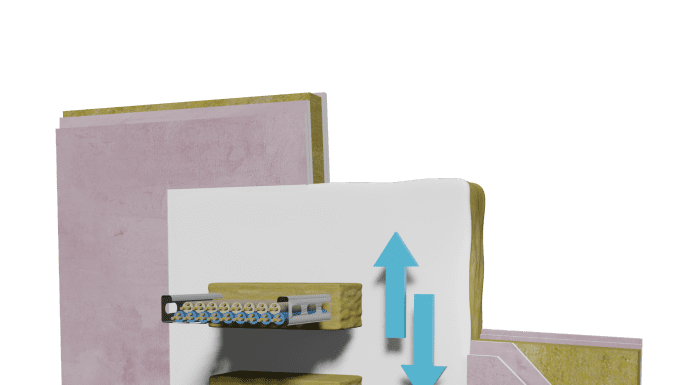Craig Abbott, technical director at passive fire protection specialist FSi Promat, highlights the importance of considering building movement when installing life-critical fire-stopping systems to ensure compliance over the building’s lifespan
Fire-stopping products are designed to prevent the spread of fire, smoke and toxic gases through joints and service penetrations in building structures, such as walls, floors and ceilings. These openings are necessary for the passage of pipes, cables, ducts and other services between different compartments of a building.
Failing to accommodate for the movement that is inherent in new and established buildings means risking damage to the fire-stopping systems and them becoming non-compliant.
Accommodating movement must be a consideration right from the design stage, taking a belt and braces approach to getting it right first time.
Addressing gaps in movement testing for penetration seals
Within the requirements of the Building Regulations, Approved Document B (fire safety) the need for comprehensive passive fire protection is well laid out.
Passive fire protection needs to be installed in all new buildings to protect lives in the event of a fire by providing a safety net that delays the spread of smoke, heat, and flames to allow occupants to escape.
However, while linear joints are tested for movement as part of the European Technical Assessment (ETA), for penetration seals, there is no pre-requisite for movement under the ETA, meaning there is currently no formal mechanism for testing it in these products.
All buildings move, although some more than others through factors such as thermal expansion, seismic movement, wind load and settlement from the loading and unloading of the building.
This movement can cause rigid building materials to crack over time and, in the case of fire stopping, those cracks could cause a failure of the product in the event of a fire, allowing fire to spread quickly through a building.
Giving consideration to these factors in the specification of passive fire protection is essential to ensure the right products are used to maintain the seal and compartmentation despite the movement imposed on it.
Planning for passive fire protection
The scope for movement needs to be factored in through the use of devices such as heat maps that show where movement occurs, and the passive fire protection requirements should be identified and planned early in the design stages to allow suitable systems to be sourced, and adequate fire-stopping configurations to be planned.
For example, if spacings between services and/or substrates isn’t sufficient then the required movement level cannot be achieved.
It is critical to remember if your substrates are subjected to movement and your services are rigidly fixed to your substrate then movement for services must also be considered. Early engagement with all key stakeholders, including fire-stopping manufacturers is crucial to identify and allow for this.
Different buildings bring different challenges in installing passive fire protection and ensuring the seal and compartmentation remain intact.
Compliance is a must, which means that in the case of a complex project, specialist support is needed to find innovative solutions to put adequate passive fire protection in place.
Case study: 21 Moorfields in London
Projects such as 21 Moorfields in London highlight the complexities of movement. Situated above a tube station, which meant it couldn’t be piled into the ground, steel has been cantilevered over the station and the building settles each day as employees arrive and leave, creating a see-saw effect throughout the day.
Through onsite collaboration with the developer and contractor, FSi Promat was engaged early in the project to create and methodically test a bespoke system to accommodate for this high level of movement, with innovation being key to finding a compliant solution.
When it comes to testing products for movement performance, while there is no prerequisite for movement within penetration seals, Approved Document B does state the requirement for an “appropriate” fire seal.
However, since there is no formal test, the challenge when it comes to movement is finding a recognised solution that meets all of those demands to create a compliant seal around penetrations over the lifetime of a building.
FlexiCoat: A flexible, elastomeric coating
To meet these varied needs of movement in fire-stopping penetration seals, FSi Promat has created a flexible, elastomeric coating. FlexiCoat is a proprietary sealing solution that has been tested to allow for up to +/-25% movement.
With no ETA available to test the solution, FlexiCoat has instead undergone, and passed, the EN1366-4 testing for linear joints and subsequently, using established fire engineering rationale and methodology, a technical assessment has been developed in conjunction with a UKAS-accredited certification body to confirm FlexiCoat’s extension, compression and shear movement when installed as a service penetration fire stopping system.
This flexible, ablative product is available as a coating to be applied to stone/mineral wool backing materials, and as a pre-coated mineral wool as a ready-made solution; FlexiCoat Fingers are made up of an 80kg mineral wool, which has a lamella core to give it enhanced flexibility, and the FlexiCoat coating applied to it is able to flex and mould to accommodate this.
Built up vertically, the blocks of mineral wool can be adapted to meet the different movement requirements of fire-stopping linear joints (EN1366-4) and penetration seals (EN1366-3), as well as curtain wall and perimeter façade applications (EN1364-4).
Compliance exists to maximise safety and it is essential that passive fire protection remains compliant for as long as a building will be in use. Accommodating movement from the earliest stage, and planning in an appropriate solution, will allow buildings to remain as safe as possible in the event of a fire breaking out.
Even when the challenges may appear considerable, FSi Promat has the expertise, passion for innovation and products to guide you along the way.
Craig Abbott
Technical Director
FSi Ltd
Tel: (0) 1530 515130
Please note: This is a commercial profile
The post Ensuring passive fire protection compliance with building movement appeared first on Planning, Building & Construction Today.


